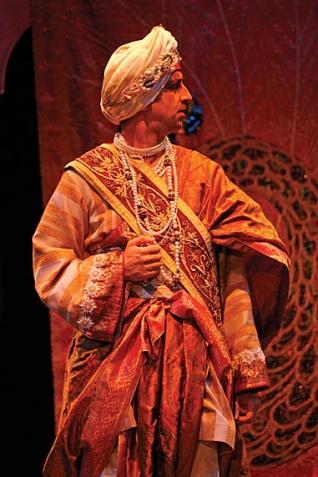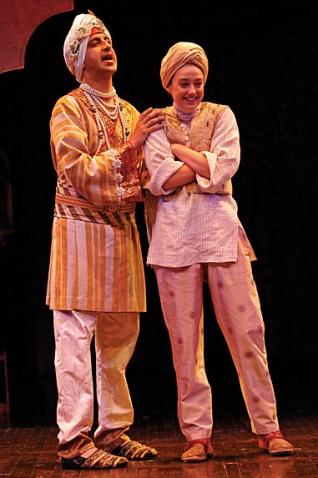Columnists
Turban Shakespeare
by Henna SinghThis October, I attended a performance of William Shakespeare's Twelfth Night at the world-renowned Stratford Festival of Canada. This festival takes place every year in Stratford, Ontario and boasts the largest repertory theatre in the world. Its season lasts from early spring to late fall, and though the theatre places emphasis on plays by Shakespeare, the repertoire also includes plays by other dramatists such as Brecht, Ibsen, and Molière. The plays change yearly and feature the work of renowned directors, costume designers, and actors.
Twelfth Night centers on the fate of a set of twins, Viola and Sebastian, who are shipwrecked. They are separated and then washed ashore on Illyria, an exotic and unfamiliar land. In order to protect herself from the harms that may befall a woman traveling alone, Viola decides to disguise herself as a eunuch named Cesario. She comes to be employed in the service of Duke Orsino and inevitably falls in love with him, though he is in pursuit of another noble-woman named Olivia. But, Olivia falls in love with Cesario when he is sent to woo her on behalf of the Duke. And so the story unfolds ...
The little known fact about this year's Stratford production of Twelfth Night is that all the costumes are Sikh themed and distinctly so. As soon as the audience is in their seats, they know that the play will take them far from the traditional, stereotypical "British" setting. The sound of a sitar fills the air and the stage of the Festival Theatre is decked out with a dome that would be equally at home in a gurdwara or the Punjabi countryside. Beige curtains remind one of rich marble. Are we at Maharaja Duleep Singh's Royal Court in Lahore? Or even Elveden?
It turns out that Illyria, the faux locale where the play's twins end up, is here set as a 19th century Sikh kingdom. The turn of the century setting is not uncommon for the staging of Shakespeare's plays. That they are versatile enough to be set in almost any century is proof of the writer's ability to delve into the universality of human nature. Yet, the scene of Punjab is still unexpected and a welcome surprise.
Leon Rubin, the play's Director says: "I've tried to re-imagine Shakespeare in a more global and cultural context. ... Setting Twelfth Night in India is very much part of [that] journey." He continues: "It was a deliberate choice to set Twelfth Night somewhere other than the traditional Western European setting used for the works of Shakespeare. We're trying to widen perspective."
Though Rubin's vision was the starting point of the setting, it was costume designer John Pennoyer's visualization of that theme that brought in the Sikh influence. When doing research on costumes, Pennoyer was significantly inspired by Franz Xavier Winterhalter's famous portrait of Maharaja Duleep Singh and decided to dress Duke Orsino in clothing similar to that captured by Winterhalter. The Winterhalter painting is the most iconic painting done of the last Emperor of the Punjab.
Winterhalter is widely known as one of the best portrait painters of the 19th century and had painted most of the European royalty of the time. Queen Victoria had commissioned him to paint the Maharaja at Buckingham Palace in 1854, after he had been "exiled" to Britain and was virtually part of Victoria's household. The painting now lies in the royal collection of HM Queen Elizabeth II.
After seeing the painting of Maharaja Duleep Singh, Pennoyer was determined to have Sikh costumes. Doing extensive research on the Internet, Pennoyer came across videos of how to tie a turban. Indeed, he was aware of the delicacies of representing a culture he was unfamiliar with and felt that if the play was taking place in a Sikh kingdom, it had to be done properly. And so, the turbans are tied perfectly. Not only do they look authentic, they are authentic.
Pennoyer also looked at photographs and books in order to learn what he could about the culture. Not only was the Duke wearing a turban, but so were other characters such as Valentine and Curio, the Duke's retainers. When Viola goes undercover as Cesario, she too wears a turban, and Pennoyer maintains that the turbans helped him with the disguise. Sebastian also wears a turban as does his friend Antonio. Furthermore, the Sikh-dressed men wear kurtas and sherwanis which further tie them to the theme.
The part of Duke Orsino was cast to Sanjay Talwar purposefully and the company considers itself fortunate to be able to have a real Indian playing the part of the Duke. Thus, physically, Duke Orsino is a reminder of Maharaja Duleep Singh - turbaned and dressed richly in beige silk. As the audience sees him in a more informal moment, they see that he has long hair making him more believable as a Sikh. Pennoyer adds that the turban was especially helpful in turning Viola into Cesario - they could easily and convincingly cover her long hair with the turban, while the kurtas were so loose-fitting that her feminine shape was unobtrusive and secreted.
But perhaps the most interesting use of costumes by John Pennoyer is that of Olivia, a young woman devastated by the death of her brother and taken to wearing black mourning dress. Pennoyer says that he saw Olivia as being hampered by her traditions and fighting to free herself from them at the beginning of the play. When she falls in love, she accepts where she is living and so changes into Punjabi clothes as she lets go of the past. We see Olivia move on from mourning her brother and desperately clutching to the memory of England, to wearing colourful clothing instead and welcoming a new man into her life. Her transition comes in stages mirrored by her clothing: she goes from wearing black to draping a sort of sparkling dupatta over her dress to wearing a sari.
The beauty of the Punjabi theme neither starts nor stops at the costumes. The music, the presence of extras on stage playing the role of musicians or servants, the presence of tablas and sitars, and the simple but close-to-the-ground furniture helped in taking the audience to a different land. We knew we were not in England. We were in Leon Rubin and John Pennoyer's Illyria. And Punjab!
Conversation about this article
1: Sobha Singh (Canada), August 29, 2009, 3:20 PM.
I am mesmerized by the majestic look of the Sikh turban, wondering how could it ever go out of style..




